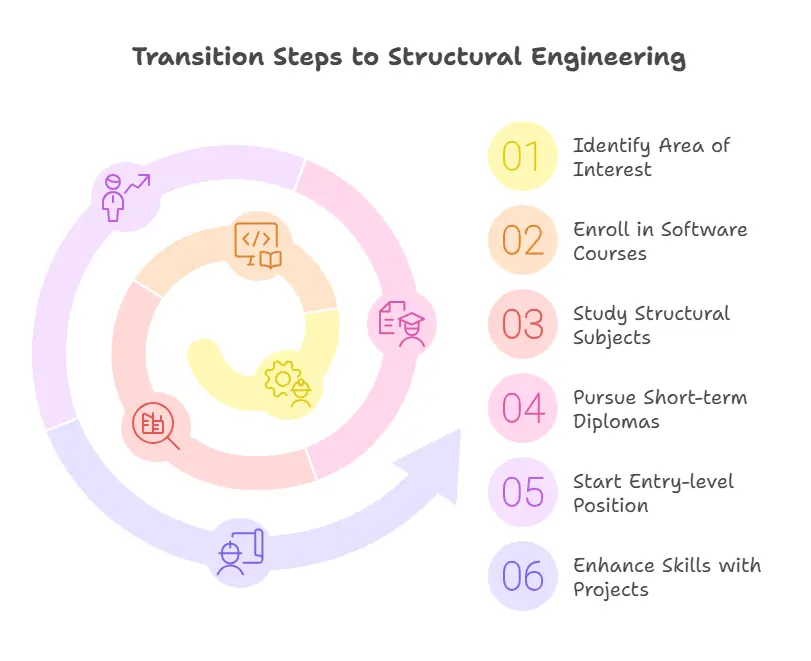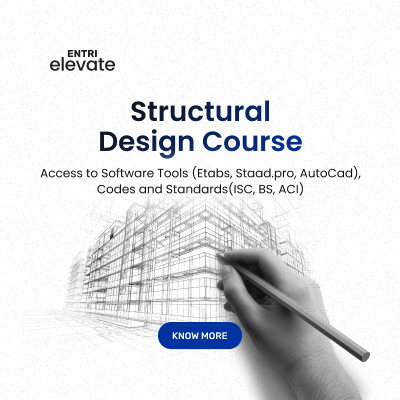Table of Contents
If you’ve been employed as a site engineer and would like to transition into structural engineering, you’re not the only one. A significant percentage of civil engineers start out working on site, developing practical experience with construction techniques before ending up with an interest in design and analysis. Making the transition to structural engineering can mean new prospects — from being involved in big projects to delving into the nitty-gritty of how buildings and bridges remain standing. Take a look at how you can turn the transition into a reality. In this blogpost, we are providing a glance of how to transform to a structural engineer from site engineering.
Build A Career In Structural Engineering! Get Free Demo Classes!!
Understanding the Role of a Site Engineer vs. Structural Engineer
A Site Engineer primarily involved in the execution phase of projects. Responsibilities include supervising construction, managing teams, ensuring quality, and handling day-to-day operations on-site. A Structural Engineer works behind the scenes in the design and analysis phase. They calculate loads, select materials, and design structural systems (beams, columns, slabs, foundations) to ensure safety, stability, and compliance with codes.
Role of a Site Engineer vs. Structural Engineer
| Aspect | Site Engineer | Structural Engineer |
|---|---|---|
| Primary Focus | Execution of construction works on-site | Design and analysis of structures |
| Work Environment | Field/Construction site | Office or design studio |
| Key Responsibilities | Supervising works, ensuring quality, managing site activities | Calculating loads, designing structures, ensuring safety |
| Interaction | Regular interaction with labor, contractors, and site teams | Interaction with architects, design teams, and clients |
| Software Use | Basic tools like AutoCAD, MS Project | Advanced tools like STAAD.Pro, ETABS, SAFE, SAP2000 |
| Knowledge Base | Construction techniques, materials, site management | Structural theory, design codes, load paths |
| Goal | Ensure timely and quality construction | Ensure safety, stability, and cost-effectiveness of structures |
| Challenges | Dealing with on-site delays, weather, labor issues | Handling complex calculations, code compliance, innovative designs |
| Career Growth Path | Site Manager → Project Manager → Construction Head | Structural Engineer → Lead Designer → Structural Consultant |
| Tools & Safety Compliance | Ensuring use of PPE, following site safety standards | Ensuring structural integrity and adherence to design standards |
Skills and Qualifications Needed to Transition to Structural Engineering
1: What is the primary purpose of structural design?
Technical Skills
- Structural analysis techniques (moment distribution, FEM, etc.)
- Knowledge of software: STAAD.Pro, ETABS, SAP2000, SAFE, AutoCAD
- Knowledge of IS codes (IS 456, IS 800, IS 875, etc.)
- Knowledge of calculation of loads and structural behavior
Educational Qualification
- Bachelor’s in Civil Engineering is required
- Master’s in Structural Engineering is highly desirable (but not required)
- Online certifications in structural analysis or design software would be beneficial
Transform Your Career with Our Structural Design Course!
Unlock Your Potential in Structural Design! Gain expert knowledge in designing robust structures and advance your career in the construction and engineering fields. Limited spots available! 🌟
Know MoreSteps to Make the Transition
- Find out which area of structural engineering fascinates you — design, analysis, software modeling, etc.
- Obtain STAAD.Pro or ETABS via online training (Udemy, Coursera, LinkedIn Learning).
- Study structural topics: RCC, Steel Design, Strength of Materials, and Structural Analysis.
- Find brief certification courses on sites such as NPTEL, Skill-Lync, or Autodesk.
- Begin with internships, fund design positions, or junior structural engineer roles.
- Include software skills, personal design project work, or analysis case studies.
Common Challenges Faced During the Transition
Switching from site engineering to structural engineering can be thrilling — but it’s not without its glitches. Let’s examine some of the most prevalent problems and how to overcome them.
Holes in Theoretical Knowledge
Your role as a site engineer is more practical and implementation-oriented. Structural engineering, however, means knowing theory fairly well — from load distribution to moment diagrams to design codes.
Challenge: It will not be that simple to remember or implement such concepts as bending moments, shear force diagrams, or FEM methods unless you are engaged in academic activities.
Solution: Go back to fundamentals of civil. Learn online tutorial lessons and problem exercises to solidify your concept foundation.
Limited Exposure to Software
Structural design and analysis rely heavily on such software packages as STAAD.Pro, ETABS, or SAFE. Site engineers might not receive much exposure to these software packages.
Challenge: Struggling to run and read structural models or outputs in the first place.
Solution: Begin with start-up tutorials and learn through hands-on experience using real examples. Certifications are also helpful.
Starting at the Junior Level All over again
Although you have a couple of years’ worth of site experience, you might be invited to take up a junior or trainee structural engineer position to start with, particularly if your design portfolio is limited.
Problem: To bear a temporary disappointment in designation or remuneration.
Solution: Consider it an investment strategy — learning about design now will pay dividends with faster growth and better positions in the future.
Adapting to Office-Based Work
Structural engineers will stay inside, studying figures, making models, and discussing with architects or consultants — just the opposite of the frenzied work outdoors.
Challenge: Adapting to screen time, sit-down work, and lengthy analysis jobs.
Solution: Welcome the transition as part of your professional evolution. Office life offers creativity, security, and long-term safety.
Code Interpretation and Detailing Awareness
Site engineers might not be directly involved in design code interpretation or detailing reinforcement drawing preparation.
Challenge: Familiarity with and application of IS codes (or ACI, Eurocode), and preparation of proper detailing might look daunting at first.
Solution: Begin by solving design examples and learning detailing standards. With experience, you will be comfortable with drawing conventions and code clauses.
Shift from Execution to Design Mindset
There, you are working with what is already established. As a structure engineer now, you are building from scratch — predicting forces, behaviors, and consequences.
Challenge: Shift in mindset from “how to build” to “how to design it efficiently and safely.”
Solution: Imagine you are simultaneously the builder and designer in your mind. Your on-site experience provides you an advantage here — utilize it to design functional, efficient structures.
How to Leverage Your Site Engineering Experience
Your on-site experience can be a big plus when you make the transition to structural engineering. It provides you with first-hand experience of how buildings are constructed, the kind of problems encountered on site, and how the construction crew works. This experience makes you proficient in coming up with practical and safe buildings that are simpler to construct.
You can promote your on-site experience as follows:
- Experience of construction techniques makes it easier to come up with realistic designs
- Drawing and doing things yourself enhance your planning and detailing
- Problem-solving on site enhances your ability to solve design problems
- Communication with workers and teams makes you a more effective coordinator
- Understanding of material behavior enables you to choose the correct design strategy
Your hands-on experience brings greater value to your design abilities — leverage it as an asset!
Transform Your Career with Our Structural Design Course!
Unlock Your Potential in Structural Design! Gain expert knowledge in designing robust structures and advance your career in the construction and engineering fields. Limited spots available! 🌟
Know MoreJob Opportunities and Growth in Structural Engineering
Structural engineering provides plenty of job opportunities and improved opportunities for advancement, as there is never any shortage of need for the construction and rebuilding of infrastructure. With each expanding metropolitan city and the development of new technology, structural engineers have an increasingly critical role in constructing and building secure buildings, bridges, and other structures. Structural engineering will continue to expand on a continuous basis due to the need for green construction, disaster-resistant structures, and urban planning.
Career Opportunities: Career opportunities with construction firms, architecture firms, government agencies, and consultancy businesses.
Growth Opportunities: Sustained need for infrastructure developments such as windmills and solar plants as well as green buildings.
Use of Technology: Improvements in software technologies (e.g., BIM) and materials technologies enabling creative design and construction methodologies.
Specialization Opportunities: Areas of seismic design, bridge designing, and designing tall buildings.
World Demand: Growing infrastructure needs of emerging economies mean high demand for trained engineers.
Sustainability Focus: Increased demand for green designs and energy-efficient structures.
Build A Career In Structural Engineering! Get Free Demo Classes!!
Building a Network in the Structural Engineering Field
Structural engineering provides plenty of job opportunities and improved opportunities for advancement, as there is never any shortage of need for the construction and rebuilding of infrastructure. With each expanding metropolitan city and the development of new technology, structural engineers have an increasingly critical role in constructing and building secure buildings, bridges, and other structures. Structural engineering will continue to expand on a continuous basis due to the need for green construction, disaster-resistant structures, and urban planning.
- Career Opportunities: Career opportunities with construction firms, architecture firms, government agencies, and consultancy businesses.
- Growth Opportunities: Sustained need for infrastructure developments such as windmills and solar plants as well as green buildings.
- Use of Technology: Improvements in software technologies (e.g., BIM) and materials technologies enabling creative design and construction methodologies.
- Specialization Opportunities: Areas of seismic design, bridge designing, and designing tall buildings.
- World Demand: Growing infrastructure needs of emerging economies mean high demand for trained engineers.
- Sustainability Focus: Increased demand for green designs and energy-efficient structures.
Final Thoughts
Moving from site engineering to structural engineering is rewarding and demanding. It demands commitment, time, and willingness to learn. But your site experience provides you with a special strength — bringing work knowledge together with an appreciation of the design.
So, whether it’s the structural theory that you cram on nights or the design tool drills on weekends, realize that each step counts toward making you a well-rounded structural engineer for the future.
Build A Career In Structural Engineering! Get Free Demo Classes!!
Transform Your Career with Our Structural Design Course!
Unlock Your Potential in Structural Design! Gain expert knowledge in designing robust structures and advance your career in the construction and engineering fields. Limited spots available! 🌟
Know MoreFrequently Asked Questions
What is the difference between a civil engineer and a structural engineer?
Civil engineering is a broad field that includes transportation, environmental, and geotechnical engineering, while structural engineering is a specialized branch focused on the framework of structures.
Is structural engineering a good career choice?
Yes, it is a respected and stable profession with opportunities in both public and private sectors, offering good salaries and the satisfaction of creating long-lasting structures.
What are some trending topics in structural engineering today?
Current trends include smart materials, earthquake-resistant design, modular construction, Building Information Modeling (BIM), and the integration of AI in structural analysis.
How can students gain experience in structural engineering?
Through internships, co-op programs, project-based learning, research assistantships, and participating in student competitions like bridge-building challenges.















